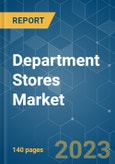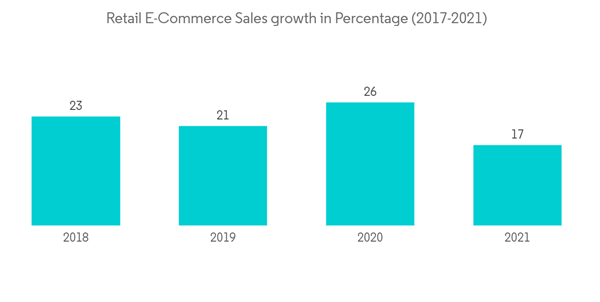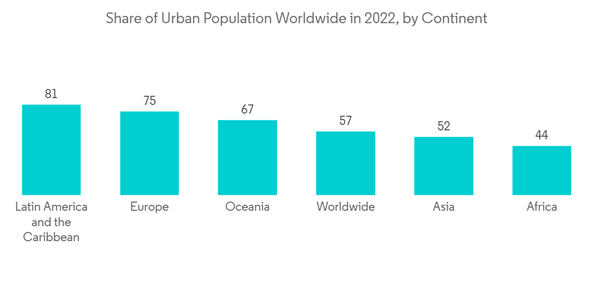Department Stores Market is expected to register a CAGR of more than 6% over the next 5 years. The growth in population and rising income of the people have increased the demand for global products, leading to the positive trend of the departmental stores. Individuals need not go to different shops to purchase products.in this case, departmental stores help customers buy various products under one roof. Departmental stores provide convenience and save the time & energy of the customers, which also drives the market's growth.
Departmental stores are usually placed in urban areas and the center of the city, near all types of transportation. Department stores have numerous benefits, such as providing clothing stores, food courts, and much more in a single place by different vendors. The stores offer discount prices for the products with the massive trend in the market growth. Technology usage in self-checkout and automated payments in departmental stores helps the customer with a faster and correct amount of bill payments.
The COVID-19 pandemic had negatively impacted the global departmental stores due to supply chain disruption and the timely closure of the stores. Competition in this industry was highly aggressive and involved many changes from time to time to incorporate new ideas and new discounts that drew more consumers to the stores. Most department stores offered all price range products irrespective of the income level of the customers to attract and satisfy the income level of customers.
This product will be delivered within 2 business days.
Departmental stores are usually placed in urban areas and the center of the city, near all types of transportation. Department stores have numerous benefits, such as providing clothing stores, food courts, and much more in a single place by different vendors. The stores offer discount prices for the products with the massive trend in the market growth. Technology usage in self-checkout and automated payments in departmental stores helps the customer with a faster and correct amount of bill payments.
The COVID-19 pandemic had negatively impacted the global departmental stores due to supply chain disruption and the timely closure of the stores. Competition in this industry was highly aggressive and involved many changes from time to time to incorporate new ideas and new discounts that drew more consumers to the stores. Most department stores offered all price range products irrespective of the income level of the customers to attract and satisfy the income level of customers.
Department Stores Market Trends
Increase in Retail E-Commerce Sales have the Negative Impact on Department Stores Market
E-Commerce is the most popular platform to purchase any product by simply sitting at home. E-commerce is one of the significant challenges for the department store market. The entire e-commerce industry has grown dramatically over the years, and as a result, adoption rates for different platforms have also increased. Global e-commerce sales grew at an optimistic growth rate in 2021 compared to the previous year. China and South Korea are ranked first and third on the list of countries with a significant share of retail sales expected to occur online in 2022. Major online platforms are Amazon, eBay, Aliexpress, Target, and Walmart, etc. online sales are expected to reach double-digit growth in the forecast period.Rise in Urban Population is Driving the Growth of Departmental stores
In 2022, the degree of urbanization worldwide was at 57 percent. North America was the region with the highest level of urbanization, with over four-fifths of the population residing in urban areas. Departmental stores are mainly located in Urban areas. If the population is more, it will directly impact purchasing daily needs. By 2025, city-dwellers will account for some $20 trillion of the annual global economy. Because retail follows people, retailers must plan to cater to these shoppers' needs and priorities and their concentrated purchasing power to remain competitive.Department Stores Industry Overview
The report covers major players operating in Global Department Stores Market. In terms of market share, few of the major players currently dominate the market. The stores offer a wide range of luxury and fashionable products both from domestic and international brands to attract customers. Following is the list of major companies operating in the market: Marks and Spencer Group Plc, Macy's Inc, Sears Holdings Corp, Target Corporation, and Nordstrom, Inc.Additional Benefits:
- The market estimate (ME) sheet in Excel format
- 3 months of analyst support
This product will be delivered within 2 business days.
Table of Contents
1 INTRODUCTION
4 MARKET DYNAMICS AND INSIGHTS
5 MARKET SEGMENTATION
6 COMPETITIVE LANDSCAPE
Companies Mentioned (Partial List)
A selection of companies mentioned in this report includes, but is not limited to:
- Marks and Spencer Group Plc
- Macy's Inc
- Sears Holdings Corp
- Target Corporation
- Nordstrom, Inc.
- Walmart Inc
- Isetan Mitsukoshi Holdings Ltd.
- Kohl's Corporation
- Chongqing Department Store Co. Ltd
- Lotte Department Store*
Methodology

LOADING...










